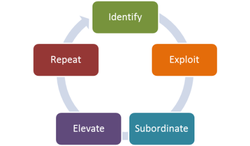THEORY OF CONSTRAINTS
|
The theory of constraints methodology is a manufacturing tool that identifies the most important limiting factor or constraint within a manufacturing system and systematically improving said constraints until it is no longer the bottleneck. The cycle continues repeatedly, constantly taking the weak link and improving upon it until something else is the weak link.
|
5 Focus Steps
- Identify the systems constraints - identify the single part of the process that limits the (in this case) throughput of the production
- Decide how to exploit said constraint - try to improve the constraint using existing resources
- Subordinate and synchronize to the constraint - review improvements and ensure they fit the needs of the system as a unit.
- Elevate performance of constraint - if the constraint still exists, take measures to "break" the constraint, ie make another process the constraint. May include capital investment
- Repeat - once the constraint has been broken, the process is repeated, taking the next constraint, or bottleneck.
The Thinking Process
The thinking process is a feature of the theory of constraints regarding the problem solving aspect, with a cause and effect methodology, ie find the cause, state the resultant of that cause, then remove the effects without causing new ones.
Implementing TOC
|
1. Identify constraint
This step is all about making maximum improvements with minimum investment. Maximise throughput on the constraint by doing some of the following things;
Once the constraint has been improved, focus move to the non-constraint equipment, making sure the upstream processes supply a steady flow of work to the constraint, never starving, and equally downstream not demanding large batches or blocking throughput. 4. Elevate performance of constraint Once a solution has been found to the constraint, then it must be properly implemented, this normally involves capital investment, machinery, employees training etc. 5. Repeat Once the constraint has been broken, the process then begins again, finding the new constraining process and improving. If the process constraint has not been broken, the process begins again, re-evaluating the constraint and checking it was correctly identified, then repeating the process. |
|
